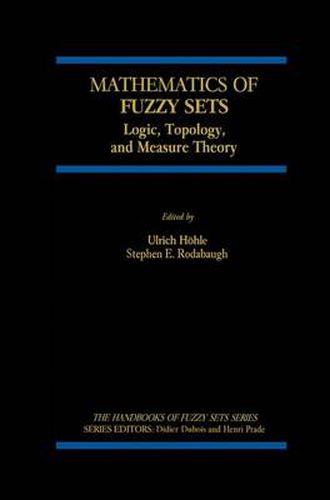Readings Newsletter
Become a Readings Member to make your shopping experience even easier.
Sign in or sign up for free!
You’re not far away from qualifying for FREE standard shipping within Australia
You’ve qualified for FREE standard shipping within Australia
The cart is loading…






This title is printed to order. This book may have been self-published. If so, we cannot guarantee the quality of the content. In the main most books will have gone through the editing process however some may not. We therefore suggest that you be aware of this before ordering this book. If in doubt check either the author or publisher’s details as we are unable to accept any returns unless they are faulty. Please contact us if you have any questions.
An attempt to provide coherence for the mathematics of fuzzy sets, much of this book is new material required to standardize this mathematics, making this volume a reference tool with broad appeal as well as a platform for future research. Fourteen chapters are organized into three parts: mathematical logic and foundations (Chapters 1-2) topology (Chapters 3-10), and measure and probability theory (Chapters 11-14). Chapter 1 deals with non-classical logics and their syntactic and semantic foundations. Chapter 2 details the lattice-theoretic foundations of image and preimage powerset operators. Chapters 3 and 4 lay down the axiomatic and categorical foundations of general topology using lattice-valued mappings as a fundamental tool. Chapter 3 focuses on the fixed-basis case, including a convergence theory demonstrating the utility of the underlying axioms. Chapter 4 focuses on the more general variable-basis case, providing a categorical unification of locales, fixed-basis topological spaces, and variable-basis compactifications. Chapter 5 relates lattice-valued topologies to probabilistic topological spaces and fuzzy neighborhood spaces. Chapter 6 investigates the important role of separation axioms in lattice-valued topology from the perspective of space embedding and mapping extension problems, while Chapter 7 examines separation axioms from the perspective of Stone-Cech-compactification and Stone-representation theorems. Chapters 8 and 9 introduce the most important concepts and properties of uniformities, including the covering and entourage approaches and the basic theory of precompact or complete[0,1]-valued uniform spaces. Chapter 10 sets out the algebraic, topological, and uniform structures of the fundamentally important fuzzy real line and fuzzy unit interval. Chapter 11 lays the foundations of generalized measure theory and representation by Markov kernels. Chapter 12 develops the important theoryof conditioning operators with applications to measure-free conditioning. Chapter 13 presents elements of pseudo-analysis with applications to the Hamilton-Jacobi equation and optimization problems. Chapter 14 surveys briefly the fundamentals of fuzzy random variables which are [0,1]-valued interpretations of random sets.
$9.00 standard shipping within Australia
FREE standard shipping within Australia for orders over $100.00
Express & International shipping calculated at checkout
This title is printed to order. This book may have been self-published. If so, we cannot guarantee the quality of the content. In the main most books will have gone through the editing process however some may not. We therefore suggest that you be aware of this before ordering this book. If in doubt check either the author or publisher’s details as we are unable to accept any returns unless they are faulty. Please contact us if you have any questions.
An attempt to provide coherence for the mathematics of fuzzy sets, much of this book is new material required to standardize this mathematics, making this volume a reference tool with broad appeal as well as a platform for future research. Fourteen chapters are organized into three parts: mathematical logic and foundations (Chapters 1-2) topology (Chapters 3-10), and measure and probability theory (Chapters 11-14). Chapter 1 deals with non-classical logics and their syntactic and semantic foundations. Chapter 2 details the lattice-theoretic foundations of image and preimage powerset operators. Chapters 3 and 4 lay down the axiomatic and categorical foundations of general topology using lattice-valued mappings as a fundamental tool. Chapter 3 focuses on the fixed-basis case, including a convergence theory demonstrating the utility of the underlying axioms. Chapter 4 focuses on the more general variable-basis case, providing a categorical unification of locales, fixed-basis topological spaces, and variable-basis compactifications. Chapter 5 relates lattice-valued topologies to probabilistic topological spaces and fuzzy neighborhood spaces. Chapter 6 investigates the important role of separation axioms in lattice-valued topology from the perspective of space embedding and mapping extension problems, while Chapter 7 examines separation axioms from the perspective of Stone-Cech-compactification and Stone-representation theorems. Chapters 8 and 9 introduce the most important concepts and properties of uniformities, including the covering and entourage approaches and the basic theory of precompact or complete[0,1]-valued uniform spaces. Chapter 10 sets out the algebraic, topological, and uniform structures of the fundamentally important fuzzy real line and fuzzy unit interval. Chapter 11 lays the foundations of generalized measure theory and representation by Markov kernels. Chapter 12 develops the important theoryof conditioning operators with applications to measure-free conditioning. Chapter 13 presents elements of pseudo-analysis with applications to the Hamilton-Jacobi equation and optimization problems. Chapter 14 surveys briefly the fundamentals of fuzzy random variables which are [0,1]-valued interpretations of random sets.